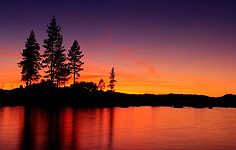
Do you ever wish you could use those turbos in real life too?
Well, in photography, you can! Sort of.
The secret is to dedicate at least one full week to nothing but photographing nature. It’s kind of like a mini photography boot camp.
Take a week off work, and go on a long road trip, visiting places you’ve never been before, but have always wanted to check out. It’s important for these places to be “fresh” to you, because it’ll excite you to visit someplace new and that usually translates to a stronger urge to create a photograph.
I took a trip like this a few years ago, and still consider it the biggest learning experience I’ve had as a photographer.
As nature photographers, we usually only get to use our cameras on the weekend, so dedicating a full week to photography will really help you see as the camera sees.
Have you ever looked at a scene and said, “Wow! I need to photograph this!” and then you took a photograph, but when you looked at the photo later on your computer, you were disappointed? Sometimes a scene that looks great through our eyes doesn’t always translate too well in a photograph, so taking a trip like this will really help you learn what does translate well to a photograph.
In his great book, Inner Game of Outdoor Photography, Galen Rowell explains how sometimes when he stopped photographing for awhile, he started to forget how the camera sees. And, so, when he picked up the camera again, it took him awhile to start producing great images again. It’s simple: the more you photograph, the more you’ll understand how to translate scenes into photographs.
Anyway, here are some keys to making a trip like this successful:
Spend no more than two days at a location. In order to keep your excitement up, and your creativity fresh, try not to spend too much time at one location. Usually one day of scouting, and one day of executing planned shots is good enough.
Scout the landscape before creating your final image. When you get to a new location, it’s important to scout it out before deciding on a composition for those golden hours of sunrise and sunset. But, don’t just walk around and take notes of good locations. You’ll learn the most about composition if you actually take photos of potential scenes, review those photos on your laptop later that night, select the best one, and then go back the next day to create the same photograph during the golden hours.
Stay at a cheap motel every night. Camping is always a lot more fun, but staying at a cheap motel every night will allow you to check out your photos from the day. And, it’s important to get this immediate feedback, because if you wait a week until you get home, that scene will no longer be fresh in your mind and it’ll be mixed in with all of your other shots. If you wait a week, you won’t be able to immediately correct your mistakes anymore.
Other things you’ll learn on a trip like this
This trip isn’t just about learning how the camera sees. You’re also likely to learn a ton of other good stuff. Here’s just a handful of what else you might learn:
You’ll learn to memorize the fields of view for different focal lengths, so you won’t have to guess anymore about what lens you need to put on your camera.
You’ll start memorizing what shutter speeds you need for certain situations (like what to use on a cloudless day at sunset and f/16).
You’ll learn how moving your camera just one inch to the right can totally ruin a photo (even a landscape photo).
You’ll learn how to visualize and manipulate a scene in your mind, so you’ll no longer have to run around a scene looking through your viewfinder until you find the perfect spot.
You’ll learn how important luck is with landscape photography
And, lots more!
So, go start planning! Now!
And, if you’ve taken a trip like this already, please share your experience with us by leaving a comment below, thanks!
If you enjoyed this article, and would like to read more, please signup for free updates by email or RSS.
 About the Author: Steve Berardi is a naturalist, photographer, computer scientist, and founder of PhotoNaturalist. You can usually find him hiking in the beautiful mountains and deserts of Southern California.
About the Author: Steve Berardi is a naturalist, photographer, computer scientist, and founder of PhotoNaturalist. You can usually find him hiking in the beautiful mountains and deserts of Southern California.


being new to using my D90 Nikon camera; I am very pleased with all the help and tips from your website. I very rarely get the chance to get out into the countryside (which appeals to me the most ) and I appreciate everything you send me. Could it be possible to have an in depth article on the basics of using these modern camera’s; especially getting away from using the auto settings?
rev dave